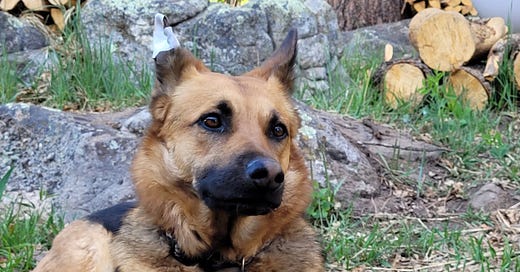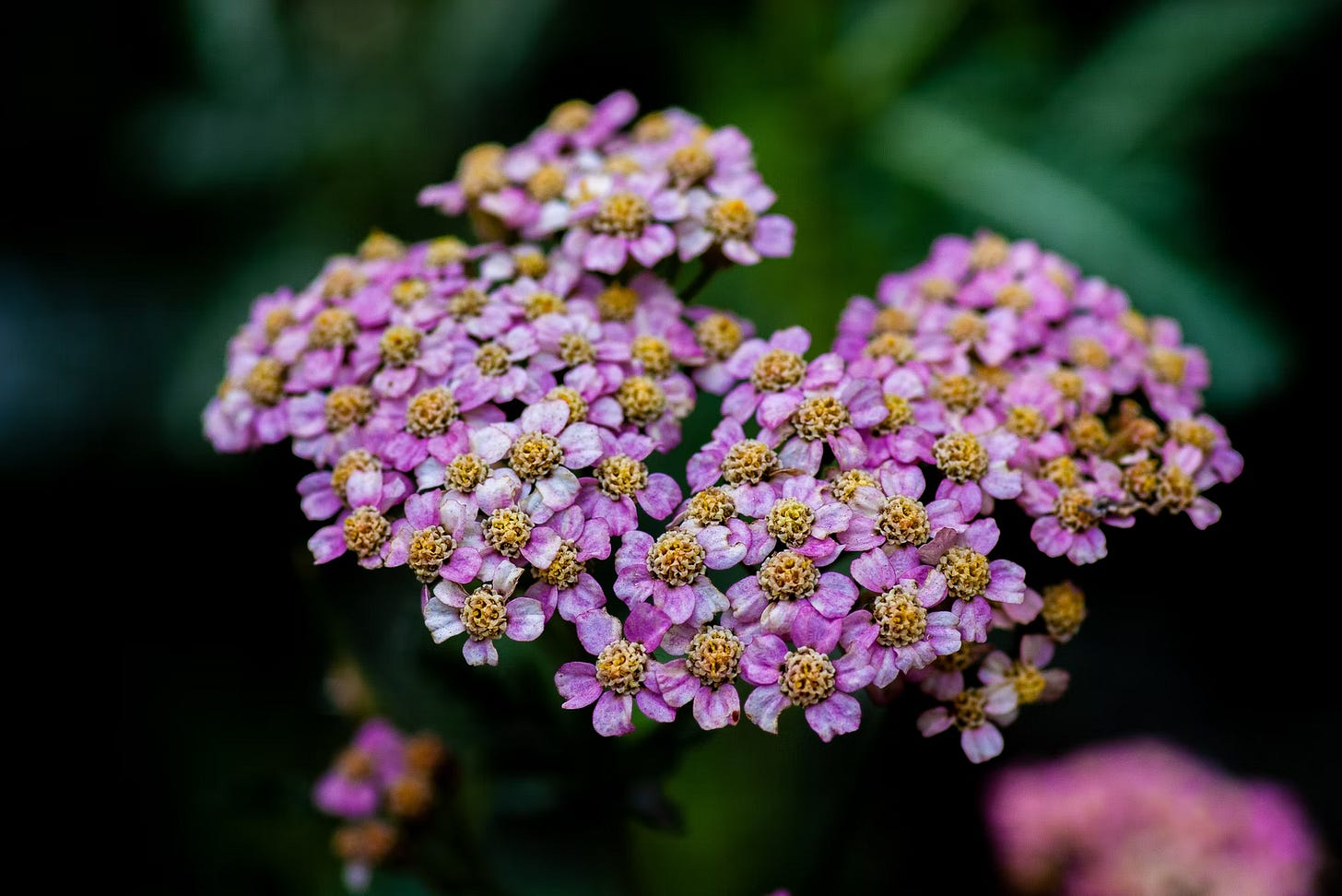This past week my dog Yoko had the brilliant idea to run through some barbed wire (see above cute face that’s impossible to be mad at). She came back to the trail with a 1/2 inch cut on her ear, streaming blood. Given that her whole ear is only about three inches wide, the cut was big enough to be a real concern, and we spent the rest of the day packaging her up, checking it for signs of infection and deliberating whether or not to go to the vet for a stitch.
Between my partner’s first aid experience as a Wilderness First Responder, and my budding herbal knowledge, we settled on a hybrid solution: A daily regimen of flushing the wound with a homemade tea of thyme and yarrow, letting it air dry, applying antibiotic ointment (letting it dry again), and packaging it with yarrow, a clean bandage and some athletic tape.
Five days later, her ear looks almost completely normal. The street-dog knick I assumed she’d have for the rest of her life is all but invisible and the yarrow (Achillea millefolium)—pictured above, which takes its name partially from the warrior Achilles and was historically used on the battlefield to package wounds, worked its magic to seal things up incredibly well.
As a vulnerary (skin-healing), styptic (stops bleeding), analgesic (relives pain), and antiseptic herb, it’s ideal for this type of injury. The thyme, which is highly antimicrobial, made for great partner in crime.
All of this to say—herbs do have their place in your first aid kit. And they can be especially helpful if you find yourself in the backcountry or out on a trail without antibiotics and all of those other modern accoutrements on hand.
Yarrow comes in a variety of colors, but only the white-flowered variety (which you can find in the wild) is medicinal.
Not all injuries should be treated at home
This goes without saying, but I’ll say it anyway. If you or one of your pets gets seriously injured, seeking professional medical help is always the path to choose. Serious injuries include things like broken bones, large wounds, and anything that’s potentially life-threatening.
We chose an at-home treatment for Yoko because her injury didn’t fall into any of these categories, although we also closely monitored her for any signs of infection and were prepared to take her to the vet at any point if her injury did become infected.
This post is not meant to discourage you from seeking professional care when an injury or illness warrants it— it’s simply meant to empower you with a few ideas for at-home remedies you can use for superficial, non-life-threatening injuries!
My goobers: Yoko (the baby who inspired this post) and Ultra (yes, like the beer and no, we didn’t name her— the mama)
Can I use the same herbs for myself and my pets?
One of the craziest things I’ve learned thus far in my studies of herbs is that a surprising number of them can be used to treat the SAME THING in both animals and humans. Loose poops? Raspberry leaf tea (an astringent) can help. Sore joints or nerve pain? Comfrey and Saint John’s Wort can be used topically no matter how much fur (or not) the patient has. And of course, there’s also a large number of first aid herbs that will work equally well on both you and your furry family members.
5 Herbs To Have In Your Herbal First Aid Kit
I. Yarrow (Achillea millefolium)
Like I mentioned up top, this herb is probably my number one go-to when it comes to herbal first aid for anything involving bleeding. The reason? Yarrow is an incredible styptic (stops bleeding), while also offering other anti-septic, analgesic and vulnerary properties. There’s a reason it was once used to treat wounds on the battlefield and that’s because it offers a very “fix it and forget it” solution. Cuts can heal over the yarrow and dissolve into skin without issue. Yoko’s ear is currently inlaid with crushed bits of yarrow leaves from a few days back, and I truly believe it’s the main reason her cut closed as completely as it did (especially without stitches)!
Where to get it: Yarrow grows widely all over the continental U.S. in dry, disturbed areas and meadows. Brush up on your wildcrafting knowledge before heading out to find some, or consider buying some seeds grow your own.
II. Thyme (Thymus vulgaris)
Highly antimicrobial, Thyme is an excellent herb to have around for cleaning wounds. Brewed into a strong tea (and cooled before application) this thyme infusion will make for a powerful skin rinse that can keep a fresh or healing wound clean.
Internally, thyme can also be used on cats and dogs (and humans) as a cough suppressant, to aid in digestive issues, and to expel worms. Although thyme is a relatively safe herb, it shouldn’t be ingested in large quantities, especially if the patient is pregnant. Also bear in mind that ingesting thyme essential oil (like most essential oils) is not considered safe.
Where to get it: Thyme can easily be grown in any well-tended flower bed, box, or on a windowsill. Besides its uses in herbal first aid, it’s also a great one to have around during cold season.
III. Calendula (Calendula officinalis)
Another powerful and relatively common medicinal herb for both pets and their humans, Calendula has a wide range of topical applications that can be helpful in first-aid situations. Containing antibacterial, vulnerary, astringent, and anti-inflammatory properties, it’s a good one to apply to a wound once the immediate risk of infection has passed, and will help things heal faster with less risk of scarring. It can be used as a poultice, or in a salve (so long as the wound is healed enough to introduce oils).
Where to get it: Calendula is fairly easy to grow from seed in a planter or in your garden. You can also buy it dried from herb suppliers like Mountain Rose.
IV. Aloe (Aloe spp.)
If you’ve ever used aloe gel to treat a sunburn, then you’re well aware of its cooling, healing abilities. Too much sun aside, the gel-like juice from an aloe plant is a great skin soother that also has antibacterial, immunostimulant, and vulnerary properties. It’s another helpful herb to have on hand to speed up the healing of an open wound (or burn) after the immediate risk of infection has passed.
Where to get it: Although aloe typically only grows natively in more exotic locales, you can easily grow one indoors as a house plant.
V. Comfrey (Symphytum officinale)
Comfrey is another amazing vulnerary, anti-inflammatory herb to have handy for treating topical injuries including burns, abrasions, flea or insect bites, or any other mild irritation. It can also be helpful in healing closed injuries like bruises, fractures and sprains.
Because the comfrey is so adept at quick healing, it has been known to seal bacteria into wound sites. For that reason, whenever treating any open injuries with comfrey (like burns), it’s best to combine it with a strong anti-bacterial herb like thyme, Oregon grape, or Saint John’s Wort. Comfrey can be used as a fresh or dried leaf poultice, a tea, or even made into a salve (for treating closed injuries).
Because comfrey leaf contains high levels of PAs (which can cause liver damage if ingested in large enough quantities), it’s best to stick to topical use of comfrey. The latest research also suggests that it’s better to grow comfrey away from any herbs you plan to ingest (and avoid using the leaves as mulch) as these can absorb some of the harmful components of comfrey—even in the garden.
Where to get it: Comfrey can easily be grown or purchased from herbal suppliers. Bear in mind that comfrey has toxic lookalikes (notably Foxglove), so proper ID is especially important!
Learning More About Herbal First Aid
If you’re serious about learning some basic herbal first aid for your pets, consider investing in this book:
For more people-centered first aid with herbs, check out this one:
Looking for more info on wildcrafting or finding medicinals that grow wild in your region? Take a gander at this comprehensive reading list put together by the Chesnut School.
New here? Follow along on Instagram (@rootedintribe) for even more herby goodness.
As an Amazon Associate, I earn a small percentage from qualifying purchases made through this post.











Such great knowledge in this post! Thank you!